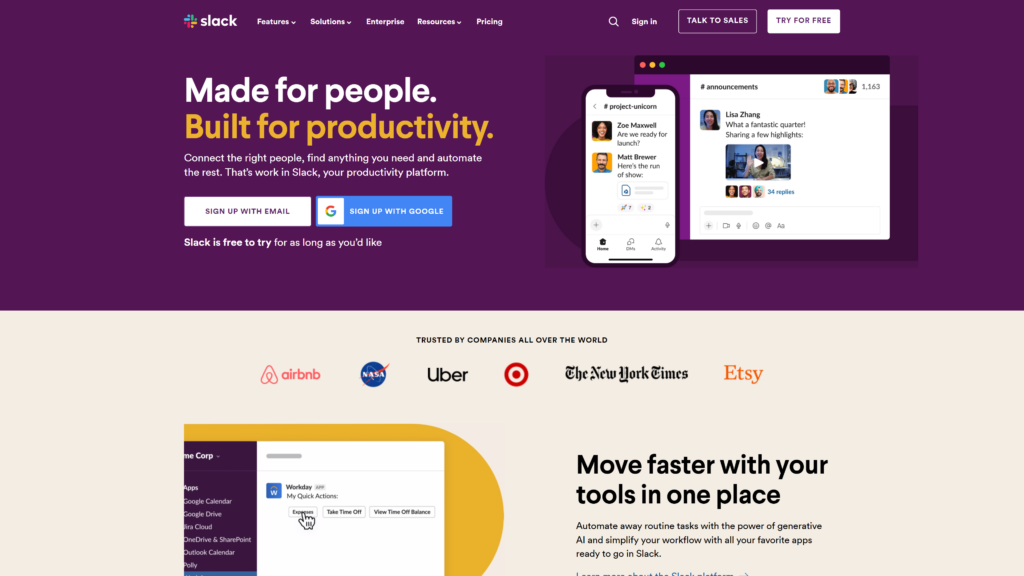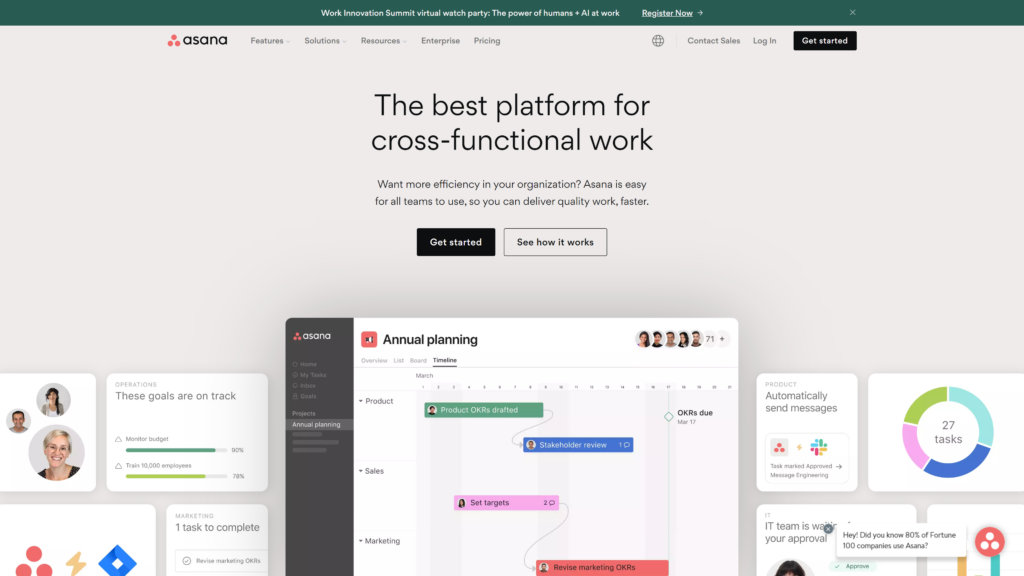In this article, we will look at some of the 10 best remote collaboration tools that help you find the right systems for your remote teams
One of the biggest determinants of success in the workplace is collaboration among employees. Collaboration is easier to manage in a physical environment.
But now that the workplace is increasingly going remote, remote collaboration applications have become essential.
In fact, a greater majority of employees are relying on the best remote collaboration tools to increase their efficiency.
These tools have project management, document sharing, and instant messaging capabilities that make it possible to engage all the team members from anywhere in the world in real-time.
But before we do that, it is important to understand what collaboration tools are.
What Are Collaboration Tools?
Essentially, collaboration tools facilitate teams to work together on common projects from wherever they are in the world.
These collaborative tools are the main driving force behind the success and efficiency of workplace teams.
They ensure better management of knowledge, facilitate internal communication, and minimize bottlenecks in the feedback processes.
With the increasing number of participants in the remote working space, it has become a necessity for companies, both large and small, to set up collaborative tools to ensure that their teams remain united and in sync at all times.
Failing to provide your workers with the best remote collaboration tools means that your organization hasn’t appreciated the new paradigm shift.
Needless to say, that is a significant future threat to your existence. If you are still doubting, here is a reality check:
- The adoption of remote collaboration tools boosts employee productivity by up to 30%.
- About 90% of workers find digital tools in the workplace very useful for remote team management and collaboration.
- More than 50% of businesses have increased their investment in remote collaboration software.
Here are some ways in which the best remote collaboration tools can help your team:
- Increase productivity: Robust collaboration tools usually have a set of powerful features that help maximize efficiency and productivity. Some of these top features include brainstorming, virtual whiteboards, and sharing tools.
- Better communication: Irrespective of the location of team members, remote collaboration tools enable them to stay in touch. With robust chat and video conferencing capabilities at their disposal, remote team members can remain connected and collaborate effortlessly even when they are miles apart.
- Improve accountability: Remote employees can remain organized if they have tools that let them track their time and request personal days. These add-ons make it easier for remote workers to better manage their availability while holding each other accountable.
The Best Remote Collaboration Tools
There are so many remote collaboration tools. However, the best ones usually provide all the main features necessary for seamless collaboration, project management, brainstorming, and communication with minimal disruption.
Our recommended remote collaboration tools come with useful features such as file sharing, chatrooms, file sharing, task tracking, time management, document management, and automated workflows.
Most of these systems are also easy to use. Actually, teams are more inclined to adopt tools that are intuitive to use in their day-to-day management.
1. Slack

If you are worried about your team communication getting disorganized, you should try Slack. It is more than an instant messaging app.
This collaborative tool can help you streamline your work and messages to a central point. This way, you can find contacts, communications, projects, and to-do tasks in one dashboard.
The status updates give you a clue as to who is available and who is not. The best thing about Slack is that you can chat one-on-one, publicly in open groups, or even post quick requests.
It is also very useful for posting updates, making team announcements, and sharing ideas and thoughts.
Pricing
- It has a free plan that supports voice and video calls.
- Premium plans include the Pro, which costs $8.75 for each user per month; the Business package, which starts at $15 per user per month; and the Enterprise package, which is customizable.
2. Google Workspace

Google Workspace is among the best remote collaboration tools, with impressive collections of tools. It has a library of cloud-based collaboration, computing, and productivity applications, including spreadsheets, word processing, email, storage, and calendars, among many others.
The best thing about Google Workspaces is that it simplifies how work is done by providing a platform for collaborating better with your team.
It enables team members to stay on the same page through the above set of powerful tools.
Pricing
- Most of the tools are available for free.
- Paid options start at $1.63 per user each month.
3. Zoom

Chances are that you have already heard about zooming. This terminology took on a new meaning in the wake of the COVID-19 pandemic.
Initially, it was used in the domain of photography but is now a common word in the video conferencing world.
Zoom is one of the best remote collaboration tools for holding and coordinating virtual meetings. It has a gallery view that brings everyone to a single chat screen.
Moreover, it offers a user-friendly platform for one-on-one chats.
Pricing
- The free plan offers basic conferencing and chatting capabilities.
- The paid options start at $149 per user per month.
4. Trello

Trello is also one of the best remote collaboration tools with project management capabilities. At first glance, it offers a streamlined way to manage projects in Kanban.
If you wish to view the progress of each task or project, you just open a card. Another beautiful thing about Trello is how it automates tasks and workflows.
If you wish to give an extra boost to productivity, you can just add integrations and power-ups. And depending on your plan, you can open several boards and be able to view them in dashboard, map, table, calendar, and timeline formats.
Generally, you can do a lot with its unlimited workspaces, multi-board guests, and attached permissions.
Pricing
- The free option is more than enough for teams that want to organize their projects.
- Paid plans offer more capabilities and cost between $6 per user per month and $17.50 for each user per month.
5. InVision

This tool is a product of designers developed for designers and is for prototyping, workflow management, and collaboration.
One of its unique features is that it gives more power to users who need to deploy a design process. Invision lets you communicate with your team in real-time, move your projects forward, and gather feedback.
Another benefit of this system is that you can draw and develop design wireframes from digital whiteboards.
Pricing
- The paid plan starts at $13 for three prototypes each month.
6. Asana

Working remotely is easier today with the best remote collaborative tools, such as Asana. This project management platform is designed to keep remote, distributed teams on the same page.
Shared workspaces mean that you know exactly who is handling which tasks. Another impressive thing about this tool is the sharing of status updates.
This way, you can easily follow up with your team members and keep everyone on track.
Pricing
- The free plan offers basic project management and collaborative tools.
- The paid plan costs $10.99 for each user per month.
7. ClickUp

ClickUp is another impressive remote collaboration tool with an emphasis on project management. Its integration power empowers your team to be more creative and efficient.
With more than 15 view options, your team can coordinate project progress from different perspectives. In addition to this, ClickUp’s Mind Map and Whiteboard empower remote teams to collaborate and problem-solve asynchronously.
Some of ClickUp’s fantastic features include over 1000 integrations, over 50 task automation, a mobile app for managing projects, 15+ unique views, and mind maps for brainstorming project workflows and questions.
The only challenge of this system is that it can pose a serious learning curve for novice users.
Pricing
- A free plan is available.
- Premium plans start at $7 per user per month.
8. Zapier

Zapier allows remote teams to get things done quicker and more efficiently with workflow automation. What it does is let you connect several applications to automate tasks such as creating customer service tickets, sending emails, and creating entries in your CRM system.
With Zapier, it is possible to transfer data between different platforms and applications. It also provides detailed reporting for teams to understand their progress and adjust where necessary.
Pricing
- The free version is available but limited in functionality and features.
- Paid plans start at $19.99 per month and are based on the number of tasks carried out.
9. Todoist

Todoist is a top-level task management tool that remote professionals can utilize to collaborate and coordinate their tasks.
With Todoist’s powerful set of tools and intuitive interface, team members can easily create and assign tasks, organize projects, and set reminders for teammates and themselves.
Pricing
- A free version is available.
- Premium options start at $4 per user each month.
10. Monday

Monday is also among the best remote collaboration tools out there. This project management platform was designed with collaborators in mind.
It is not only intuitive but also offers flexible options for tracking progress, managing resources, vizualizing projects, sharing files, analyzing insights, and communicating with team members in real-time.
Pricing
- A free plan is available for individual users.
- Premium packages start at $8 per user per month.
Final Word
As you can see from the above, the best remote collaboration tools provide the necessary solution for efficient teamwork and workflow, irrespective of the location of team members.
With such tools, all your deliverable details are available at one central point, so you can have total clarity in your workflow.
The best thing about most of the recommended collaboration tools is that they can integrate seamlessly with other related tools to improve their efficiency.
By leveraging these collaborative tools, your remote teams can work more effectively, stay connected, improve productivity, and archive their project goals.
So, if you haven’t invested in the right remote collaboration tools, you have a selection of the best ones.
Also Read: 10 Best Remote Collaboration Software For 2023[Pros, Cons & Pricing]



